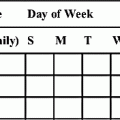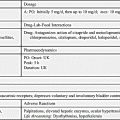http://evolve.elsevier.com/McCuistion/pharmacology
This chapter focuses on drugs commonly administered to the neonate, which includes late preterm newborns immediately after delivery.
As discussed in Chapter 49, A thorough medical history, such as acquired immunodeficiency syndrome (AIDS), Group B streptococcal infection, and viral hepatitis B or hepatitis C should be conducted. Labor is determined to be preterm if it commences before 37 weeks of pregnancy. If there are no contraindications to halting preterm labor, tocolytic therapy is administered to delay birth (see Chapter 49 for more information on pregnancy and preterm labor drugs). However, when preterm labor is not arrested, premature delivery of the neonate occurs, which puts the newborn at risk for health problems. Premature neonates are at risk for respiratory distress, hypothermia, hypoglycemia, and hyperbilirubinemia, and they may have feeding difficulties.
Drug Administered to Preterm Neonates
Synthetic Surfactant
Respiratory distress syndrome (RDS) can occur because of immature lung development and breathing control and decreased airway muscle tone and surfactant level. Surfactant, a lipoprotein, is necessary to decrease the surface tension of the alveoli (air sacs) to allow the lungs to fill with air and prevent the alveoli from deflating. Immature lungs have lower than normal levels of surfactant; the more premature the neonate is, the higher the chance of RDS. One approach used to minimize respiratory difficulties in the preterm neonate is surfactant replacement. Supplementing the amount of endogenous surfactant available to maintain distension of the alveolar sacs is the focus of this therapy.
The U.S. Food and Drug Administration (FDA) has approved the use of beractant, calfactant, and poractant alfa. Beractant intratracheal suspension, a natural bovine lung extract, contains phospholipids, neutral lipids, fatty acids, and surfactant-associated proteins to which colfosceril palmitate (dipalmitoylphosphatidylcholine, or DPPC), palmitic acid, and tripalmitin are added. Beractant does not require reconstitution. Calfactant also does not require reconstitution, nor does it need to be warmed at room temperature prior to use, unlike beractant and poractant. Poractant alfa is porcine lung surfactant and is indicated for rescue treatment, whereas beractant and calfactant are approved for prophylaxis and rescue treatment. Poractant should be slowly warmed to room temperature and also does not need reconstitution. Each of these products defines prophylactic and rescue use differently and has different dosing and administration requirements. Table 51.1 lists the surfactant drugs used for prevention and treatment of RDS along with their dosages, uses, and considerations.
TABLE 51.1
Exogenous Surfactant Therapy for Prevention and Treatment of Respiratory Distress Syndrome
| Generic | Route and Dosage | Uses and Considerations |
| Beractant | PN: IT: 4 mL/kg per dose divided into four equal amounts; administer each quarter amount followed by repositioning and extra ventilation; repeat q6h. |
Bovine-derived surfactant to be administered IT for prophylaxis and treatment of RDS in premature infants <1250 g birthweight or with evidence of surfactant deficiency within 15 min of birth or neonate with confirmed RDS requiring ET intubation by 8 h.
Drug must be given by health care personnel experienced with using ventilators for prevention or rescue in treatment of RDS.
Administer through a 5-French end-hole catheter as a dosing catheter inserted into an ET tube; do not shake; warm 20 min at room temperature or in the hand for at least 8 min.
Reposition infant to distribute drug followed by ventilation for 20 s after each quarter dose.
Does not affect the CYP450 isoenzymes.
|
| Calfactant | PN: IT: 3 mL/kg per dose divided in two equal amounts; administer each half amount over a total of 20-30 breaths during the inspiratory phase followed by repositioning and monitoring respiratory status; repeat q12h. |
Calf-derived surfactant to be administered IT for prophylaxis and treatment of RDS in premature infants <29 wk of gestational age at risk for RDS or ≤72 h of age with RDS requiring ET intubation.
Drug must be given by health care personnel experienced with ventilators and RDS.
Gently swirl the vial to ensure a uniform suspension; avoid foaming.
Draw dose with a 20-gauge needle; do not filter or dilute; administer via a 5-French end-hole catheter inserted into the proximal end of the ET tube.
|
| Poractant alfa | PN: IT: 2.5 mL/kg per dose divided in two equal amounts; administer each half amount to each main bronchus followed by repositioning and monitoring respiratory status; repeat q12h. |
Porcine-derived surfactant to be administered IT for the treatment of RDS in premature infants within 15 h of birth.
Drug must be given by health care personnel experienced with ventilators and RDS.
Warm to room temperature; gently invert to obtain uniform suspension.
Draw dose with a 20-gauge or larger needle; do not filter or dilute; administer via a 5-French end-hole catheter inserted into the proximal end of the ET tube.
|
All exogenous surfactants require a patent endotracheal (ET) tube for administration and specified alterations in positioning the infant throughout the procedure to ensure even drug dispersion. These precise position changes allow gravity to assist in the distribution of the product in the lungs, particularly at the alveolar surface.
Crackles and moist breath sounds may be a transient finding after administration of these products, particularly with beractant. Exogenous surfactant can cause postadministration complications such as hyperoxia (excessive oxygenation) and hypocarbia (decreased carbon dioxide [CO2]). Additionally, transient endotracheal reflux can obstruct the ET tube and lead to oxygen desaturation, cyanosis, bradycardia, and apnea. These issues do not usually lead to serious long-term complications when properly managed. Unless obvious signs of airway obstruction are noted, suctioning should not be performed immediately after administration of supplemental surfactant. Dosing is slowed or halted if the infant (1) becomes dusky colored, (2) becomes agitated, (3) experiences transient bradycardia, (4) has oxygen saturation increases of more than 95%, (5) experiences improved chest expansion, or (6) has arterial or transcutaneous CO2 levels below 30 mm Hg. Suctioning before dosing decreases the chance for ET tube blockage during dosing. No long-term complications or sequelae of synthetic surfactant therapy have been reported. Surfactant replacement therapy has been found effective in reducing the severity of RDS; rapid improvements in lung compliance and oxygenation may require immediate decreases in ventilator settings to prevent lung overdistension and pulmonary air leak.
Evaluation
• Evaluate preadministration breath sounds, ABGs, respiratory status, and ventilator pressure readings to compare with postadministration findings.
• Evaluate the effectiveness of teaching to parents.
Drugs Administered to Full-Term, Healthy Neonates
According to the World Health Organization (WHO, 2016), newborns should receive eye care (e.g., erythromycin ophthalmic ointment), phytonadione, and immunizations for hepatitis B. Additionally, an antiinfective agent (e.g., chlorhexidine) may be applied to the cord stump during the first few hours after birth and for up to 1 week for at-risk newborns and newborns born in homes.
Erythromycin Ophthalmic Ointment
A common antiinfective administered to a newborn’s eyes within the first hour of birth is erythromycin ophthalmic ointment. It is given as a prophylaxis against eye infections; side effects include chemical conjunctivitis in about 20% of neonates, manifesting as edema and inflammation that lasts about 24 to 48 hours. It may interfere slightly with eye-to-eye contact between parents and the neonate.
Phytonadione
Phytonadione, a synthetic vitamin K, is a fat-soluble vitamin given to newborns to prevent vitamin K–deficiency bleeding (VKDB). It is administered as a single-dose injection. Side effects include pain and edema at the injection site. Some allergic reactions, manifested by urticaria and rash, have been reported. Neonates who receive larger doses may exhibit hyperbilirubinemia and jaundice resulting from competition for binding sites.
Table 51.2 covers erythromycin and phytonadione and their dosages, uses, and considerations.
Immunizations
The American Academy of Pediatrics and the Centers for Disease Control and Prevention (CDC) have recommended that immunization against hepatitis B virus (HBV) begin in the newborn period. HBV infection may result in serious long-term liver disease, cancer, and death in adulthood. The goal of immunization is to reduce the number of chronic carriers of the virus in the population, thus decreasing the prevalence of HBV infection.
In pregnancy, HBV transmission occurs vertically—that is, by perinatal transmission—primarily at the time of delivery. Hepatitis B immune globulin (HBIG) is given to infants born to mothers who are positive for hepatitis B surface antigen (HBsAg). HBIG provides the newborn passive protection against HBV. Adverse effects of the injection include pain, tenderness, and erythema at the injection site. Hypotension, erythematous rash, and anaphylaxis after receiving HBIG can also occur.
A three-dose series vaccine for hepatitis B, recombinant hepatitis B, is indicated for HBV prophylaxis in infants; the first injection is given at birth. Recombinant hepatitis B (HB) can provide active immunity against HBV by stimulating the immune system to produce antibodies against hepatitis B (anti–hepatitis B antigen), and it can be given concurrently with HBIG if the infant is born to an HBsAg-positive mother. Recombinant HB is given as separate injection administered to separate sites. Adverse effects from recombinant HB are generally mild and include pain, tenderness, pruritus, erythema, swelling, and induration at the injection site.
Table 51.2 lists HBIG and recombinant HB and their dosages, uses, and considerations.
Evaluation
• Evaluate for newborn bleeding, particularly on days 2 and 3 after administration of phytonadione.
• Evaluate for drug hypersensitivity or side effects.
• Evaluate parents’ understanding about medications administered to their newborn.
Critical Thinking Case Study
TA, an older adolescent, was admitted to the hospital for labor induction/augmentation with signs and symptoms of gestational hypertension at 42 weeks’ gestation (gravida 4, para 1). TA’s mother arrived at the hospital when TA was dilated 8 cm and in time for the late stages of TA’s labor. Her mother remained as TA’s support person throughout the delivery, which occurred at 6:00 AM by vacuum extraction. TA had a continuous epidural for her labor and delivery. An episiotomy was performed at the time of delivery, and a fourth-degree laceration occurred. A cluster of hemorrhoids was evident. Baby JA, weighing 8 lb 7 oz, had Apgar scores of 7 and 9. The infant is alert and active.
TA lives with her parents and has been going to high school while working part time in an automotive parts store. She wants to keep her infant and to breastfeed “for at least 3 months.” She plans to finish school and return to work in 6 weeks.
Immediately after the delivery, the nurse conducts an assessment of TA, analyzes the data, and determines and prioritizes TA’s nursing care needs. The same is done for the newborn.
1. Within the standard, how should bonding be promoted—including eye contact between mother and infant—while eye prophylaxis is being administered?
2. Including safety for the nurse administering the ointment, what steps should the nurse follow to instill ointment into the infant’s eyes?
3. What should TA be taught about the side effects of eye prophylaxis?
4. How should the nurse explain the reason for the vitamin K injection for the infant in terms TA can understand?
5. Which newborns are eligible to receive the hepatitis B vaccine?
6. How many doses constitute the total series, and what is the duration for these?
7. Why is this vaccine given to newborns? Why is it important?







